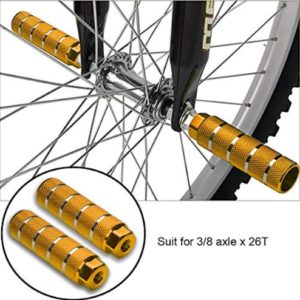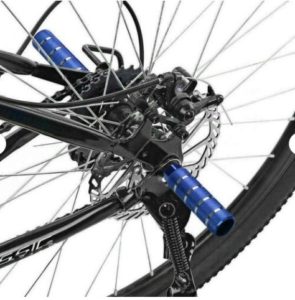Performing bicycle tricks is more fun with bike pegs, but do they serve other purposes, or are they just for display. This question culminated in asking, what are bike pegs used for?
Bike pegs allow bicycle riders to center their weight and feet on the wheel’s center, creating a stable platform for better pedaling. They are also used to perform stunts or acts on motocross or BMX bikes, offering an acrobatic pivot and facilitating different aerial maneuvers, like front wheelies.
Bicycle pegs are multipurpose accessories that help increase the number of people you can carry on your bike and expand its purpose.

What Are Bike Pegs And Their Use?
It is a tiny metal bar attached to a bike’s rear wheel, front wheel, or both. They are typically placed on the middle of a wheel at the place where the spokes come together.
You will likely see bicycle pegs on BMX bicycles because they have the ability and the frame capable of holding the pegs.
Since bicycle pegs are primarily designed to aid stunt or trick execution, most come standard on stunt and street bikes. However, you can also customize your bike with bicycle pegs.
Some bicycle riders prefer to ride without bicycle pegs, especially when racing because they make the rider less aerodynamic and compromise speed.
If you decide to get pegs for your bike, KINSPORY 3/8 inch – 26 Teeth Aluminum Alloy Pegs are worth it. They come in different colors, are suitable for back and front wheel axles, and are easy to disassemble and install.
What Are The Pegs On A BMX Bike For?
Pegs vastly expand the kinds of stunts you can pull on your BMX bike, including double peg grinds and front wheelies. You can also grind, carry a passenger, or be a passenger.
Since they let you put your weight and feet over the wheel’s center, you get a platform that’s more stable than the pedals, giving you more control over the bicycle.
The axle’s positioning make it easier to balance on a single wheel and offers a pivot point to move and rotate your BMX.
1. Grinding
You can use the pegs on BMX bikes to grind along a rail, concrete bench, or curb while you try to stay balanced on a moving bicycle.
The first step in grinding is locating the surface to grind on, then visualize the dismount and approach.
You must determine the spot where you’ll need to jump to land with the pegs. This is crucial because the wrong anticipation may land you long or short of the target and, in turn, miss with the pegs.
Knowing the surface’s length will allow you to dismount at the right time. Dismounting is complex, but you will master the whole process by practicing.
2. Riding On The Bicycle Pegs
Whether you are the passenger or carrying someone else, you must be careful when executing this trick. Pay attention to your surroundings and ensure the bike pegs can support your weight without snapping.
You can perform different tricks here, but it may take several tries to execute them flawlessly.
Carrying a passenger on the pegs isn’t recommended because bicycle pegs aren’t made to handle a lot of weight for long periods. However, if you do, it would be best if your friend rode on the rear pegs and held onto your shoulders.

Can You Put Bike Pegs On A Mountain Bike?
While mountain bikes are not the ideal choice for bike pegs, you can attach pegs to your mountain bike, but as a result, you may encounter certain issues. These problems include:
1. Quick-Release Skewers
Nearly all mountain bikes offer through-axle or quick-release skewers, which are not designed for attaching pegs to the bike’s frame. Sometimes through-axle skewers have plastic tips, making them inappropriate for metal pegs.
2. Insecure and difficult Installation
The quick-release skewers of mountain bikes are too short, and their structure and functionality are incompatible with bike pegs. In addition, you cannot tighten them after attaching the pegs.
Thru-axles are also tiny and aren’t designed to withstand excessive lateral stress. Therefore, you are left with two options of installing pegs on your mountain bikes- attaching them to the bicycle’s mounts for fenders or racks or using bolt-on axles.
The first option is weak and can damage the frame, while the second involves replacing the axles.
3. Flat tires
You will notice the effects of the additional weight if you carry someone on your mountain bike’s pegs, even if the tires are fully inflated. Strive to maintain your MTBs weight limit to avoid crippling it and constantly dealing with flat tires.
If you choose to attach bike pegs on your mountain bicycle, avoid carrying a passenger or heavy luggage.
If you are shopping for pegs for your MTB, consider Zelerdo 2 Pairs Aluminum Alloy Pegs. Zerlerdo bike pegs are ideal for 3/8-inch axles, available in many colors, have a maximum capacity of 200lbs, and suitable for mountain bikes, BMX, and regular bicycles.
Also, read: Can you put pegs on a mountain bike?
How Do I Choose A Bike Peg?
The right type and the number of bicycle pegs you get for your bicycle depend on your bike type and riding style. When shopping for pegs, consider the diameter, materials, length, and axle size.
1. Diameter
A standard peg is 1.5-inches (38.5mm) in diameter. However, you can go for skinnier ones (35mm or even less) to keep the weight on the lighter side.

2. Length
A typical stunt peg is about 4” (100mm) long. However, you can go for about 4’4” (110mm) if you have long feet or get a better grind from longer pegs.
Micro bike pegs (30mm) let you execute your axles and execute grind.
3. Axle Size
Most bike pegs are made to fit the 14mm axle seen in the most park and street bikes. On the other hand, race bikes have 3/8-inch axles, which are equipped to handle stunt riding better.
Several pegs come with adapters so that you can fix the pegs onto the 3/8-inch standard.
4. Materials
Most bike pegs are made from aluminum alloy to give a proper balance between lightweight and strong. However, cheaper options are manufactured using strong Chromoly steel.
Modern options may also have plastic or nylon sleeves, which aid smoother, longer grinds. You can also lower friction using peg wax.
Can You Put Pegs On A Road Bike?
It may not be a great idea to install bicycle pegs on your road bicycle, especially a high-end roadie. This is because high-quality road bikes have quick-release levers, which complicate your quest of having pegs on such a bike.
In such a case, you will need to purchase a new axle with extended tips to allow you to screw in the bike pegs.
The complexities of installing pegs on your roadie are minimized if you already own an entry-level road bike with a longer axle and lug nuts. This eliminates the expense of buying a new and more suitable axle, and the time you’d have spent replacing the axles can go to screwing in the pegs.
Nonetheless, remember that adding more weight to the bike’s rear-wheel will compromise the wheel’s durability and overall safety and stability. This is especially critical because the rear wheel supports the majority of the weight.

FAQs
1. Do All Pegs Fit All Bikes?
You can attach bicycle pegs to any bicycle if its wheels can support them, which typically means long axles. However, you will mostly see pegs on bicycles designed for stunts or tricks like BMX bikes.
2. Can You Put Pegs On A Mongoose Bike?
You can install pegs on your Mongoose bike for exciting rides and thrilling tricks but ensure you install them properly. You can also remove these pegs once you finish your stunts and ride your bicycle normally.
However, you will need the bicycle pegs, a screwdriver, and a ratchet to attach the pegs.
3. Can You Stand On Bike Pegs?
Generally, bicycle pegs are made for stunts not carrying passengers. However, if you have to stand on bike pegs, proceed carefully and ensure the pegs can handle your weight.
4. How much weight can bike pegs hold?
Most bikes can handle about 150lbs, although some can support up to 200 pounds. It is essential to ascertain the weight limit of your bike pegs to avoid breaking them.
5. Is It Safe To Ride On Bike Pegs?
You can safely ride on bike pegs if they can handle your weight. Also, make sure you are put on your helmet to protect you from sudden impacts.
The bike rider can see what’s in front of them and steer the bicycle properly. Furthermore, the passenger won’t be at high risk if the bike stops suddenly.
6. How Do You Attach Bike Pegs?
You can easily attach pegs on your bicycle by screwing it where the wheel spokes come together. You should see an exposed screw head if your bicycle can support a peg.
The next step is to screw the pegs onto the exposed head. Make sure you achieve a proper fitting.
7. What Size Bike Pegs Do I Need?
The ideal size of bicycle pegs to get depends on your bicycle specifications and your preferences. While the standard length of pegs is 4”, you can choose longer ones (4.4”) that offer a better grind.
The axle size is also critical, and bicycle pegs come in 3/8 inches (it offers better handling during stunts) and 14mm. In addition, you must account for a diameter that can be 38.5mm or less.
In Conclusion, What Are Bike Pegs Used For?
The bottom line is, while bicycle pegs are primarily designed to execute stunts, that is not their sole purpose. It can help you share a ride with your friend but be careful not to break the pegs and, most importantly, keep yourself safe.
Make sure the pegs are stable and secure before standing on them.